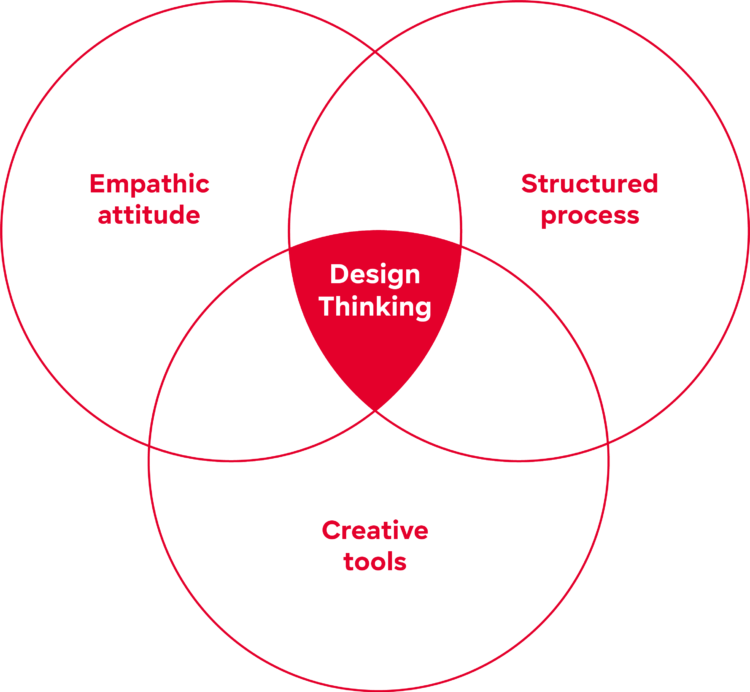
Design thinking in practice: uncovering hidden solutions together
How do companies find new, innovative solutions for products, services, and processes? The consultants at Comma Soft support their clients with design thinking, among other things, as a tool and as an underlying attitude that can be used to break through habitual thought patterns and adopt new perspectives. Dr. Christina Kratsch, Head of Research, Development & Innovation, reveals what this can look like in practice.
“How can we realign our business model and future-proof it? How can we improve processes and make our services even more attractive to customers?” These are the questions facing companies that want to remain innovative and competitive both now and in the future. Solutions based on data and artificial intelligence are playing an increasingly important role. This is because it enables the company to gain insights and make forecasts that can be used, for example, to tailor products and services specifically to end customers. Before specific technologies and use cases can be considered, however, there first needs to be a goal. What needs to be achieved, different and better? What has been the problem so far and how can it be solved? Innovative products, services and business models emerge off the beaten track. They need new perspectives, sparring partners and the curiosity to engage with the unknown. This is exactly where Comma Soft’s consultants come in with design thinking.
Finding innovative solutions with design thinking
Design thinking is a creative approach that leads to the development of new ideas. This can happen in special workshops, but also by adopting an underlying design thinking attitude. In both cases, consultants do more than just take a close look at a company’s requirements. They also put themselves in the perspective of the people who end up working with applications and processes every day. This is just one of the three pillars on which design thinking is based:

- Empathic attitude: Consultants put themselves in the shoes of the end users and recreate the everyday challenges faced by a company. At the same time, they bring their neutral observer perspective to the table, thereby broadening the field of vision and seeing the “blind spots” that can be starting points for new solutions.
- Structured process: Creativity needs breathing room, there’s no question about that. The many ideas and approaches that arise in the process are allowed to bubble up unchecked and randomly at the beginning, for instance in intensive brainstorming sessions. At a certain point, however, structure is needed again. It is through a clear structure that the loose ends are tied up, prioritized, developed into initial prototypes and finally into specific solutions.
- Creative tools: There are a variety of ways to boost creativity here: from workshops with interdisciplinary, cross-departmental focus groups to fishbowl interviews with individuals to numerous visualization options – analog with paper and pen or digital on a virtual whiteboard.
This approach gives rise to customized, practical solutions instead of ready-made off-the-shelf concepts. These examples from Comma Soft’s everyday consulting work show what this can look like in practice:
3 practical examples of design thinking
1. Research & development
How can the development cycle of medicines be shortened by a year? The Comma Soft project team investigated this question for a pharmaceutical company. After workshops in which external scientists and coaches also participated, it quickly became apparent that certain data were in silos. The limited access to them unnecessarily slowed down R&D departments. Now they are collaborating with the consultants to develop a data strategy tailored to the company that takes into account the governance requirements that are important for the pharmaceutical industry and are planning appropriate solutions to implement them. This allows employees to access the data more quickly and improves the evaluation options.
2. Production
An automotive manufacturer wanted to halve the error rate in the production of a specific manufacturing part. Here, too, data played a decisive role: the employees needed an overall view of all the production data and a way to identify discrepancies in the process at an early stage. This was the result of interviews with those involved in production, quality management and controlling, to name just a few. Based on these findings, the company was able to work with Comma Soft to find a solution: today, an AI assistance system continuously evaluates quality-relevant production data, detecting any abnormalities before they can lead to production errors.
3. Customer service & support
How can we reduce our customers’ churn rate by five percent? That’s what one insurer was able to find out with Comma Soft. The consultants’ design thinking approach informed the consulting process throughout this collaboration. Working closely with the Sales Department, the Claims Department, and the insurance agencies’ employees, they identified the problems that had arisen in the past: through its agencies, the insurance company had great potential to provide policyholders with a personalized and tailored service. However, what the agencies often lacked for this was important, up-to-date data as well as a specific perspective on it. Once this became clear, the insurance company was able to introduce a suitable solution in the form of INFONEA®.
Design thinking and co-creation creatively combined
These examples give only a glimpse of how Comma Soft’s consultants use design thinking. This results in solutions that are geared to the requirements of companies, their employees and end customers. This requires openness and a friendly corporate culture that supports mutual interaction on an equal footing – both on the part of the consultants and on the part of the customers… Once the creative process is underway, it often multiplies and provides the impetus for further new, innovative processes, products, and services.
Are you looking for support in solving specific problems or in your innovation processes? Please feel free to contact Dr. Christina Kratsch for further information.